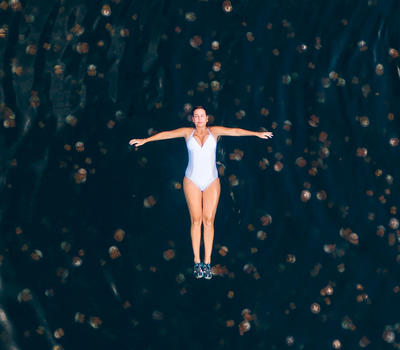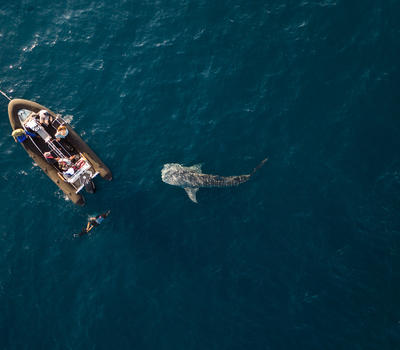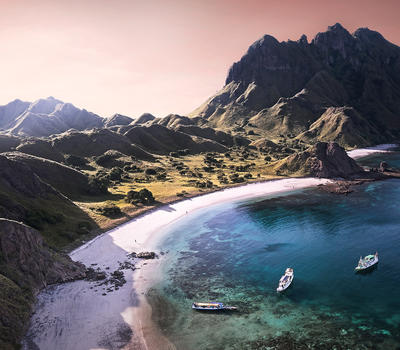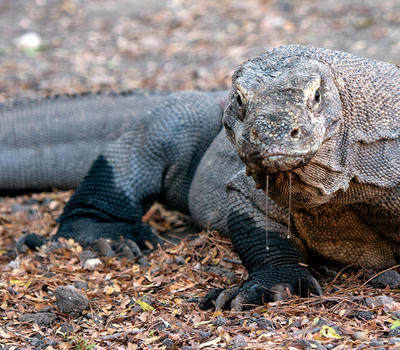Aqua Blu

Swimming with Jellyfish
Hop aboard Aqua Blu on our 12-night limited repositioning adventure cruise in order to drop by the mysterious island of Misool. Among many of this destinations rarely visited and recently discovered treasures, are two hidden marine lakes that have become the natural habitat of three species of stingless jellyfish. Misool is one of only three islands in the world that can claim such a rare experience, the other two being Palau and Kakaban island in East Kalimantan.
Lake Lenmakana, a turquoise lagoon isolated in the middle of the island, is one of the jellyfish lakes that can be reached by a short hike up a steep limestone cliffside. Despite the arduous journey, the view down onto the lake and its treasures within are worth the challenge. The moon, golden medusa, and Cassiopeia (the upside-down jellyfish) are the three different species that bob around the lake, trapped by long ago tides. The lake’s water consists of seawater, diluted with rain and groundwater, making it home to marine green algae which react photosynthetically with sunlight to produce food. Isolated from natural predators, the species no longer requires venom as self-defense. As such, a swim is in order – and what an adventure experience it is.

Swim with the Gentle Giants of the Sea
If you have ever wanted to feel the force of nature, we can think of no better way than to swim with whale sharks. As the world’s largest fish, and one of the most anticipated animal sightings in the world, an encounter with one of these gentle giants of the sea is sure to have you mesmerized. Measuring an average of 39 feet (12 m) long, whale sharks are friendly and docile creatures that filter feed off small organisms such as krill, plankton, and tiny shrimp, thus posing no threat to humans. Quite the opposite, their tranquil and slow motions make swimming or snorkeling with them a true joy – just make sure you stay a little further off while they are feeding as the suction of their colossal gaping mouths is powerful.
There are selected hotspots where encounters with the endangered whale sharks are possible in Indonesia. In fact, the Indo-Pacific region is home to three-fourths of the global whale shark population, and on our Komodo itinerary, it is quite possible to even swim with them! It is another early rising at 5 am, but oh-so-worth-it to go out on a tender journey guided by a local fisherman to a fishing pontoon somewhere in Saleh Bay. Imagine snorkeling with up to four whale sharks at a time, while the sun ascends over the high mountain ranges of Sembawa – it is without a doubt paradise found!

A magical evening at Pink Beach under the moonlit sky – Komodo National Park
If you are dreaming about paradisiacal beaches, Komodo Island’s breathtaking Pink Beach should be at the top of your bucket list. Its soft pastel pink sands and turquoise waters are just some of the unforgettable sights that will make you fall in love with the marvelous gifts of nature found in this exotic archipelago.
Its distinctive hue is created from the red pigment produced on coral reefs by microscopic creatures called foraminifera. Tiny fragments of the red coral combine with the white sands of the beach, creating this specific shade. Aqua Blu anchors in this location during the late afternoon, offering our guests a romantic and tranquil setting after a day packed with adventure, volcanoes and dragons.

Up-close encounters with Komodo Dragons, the World’s largest reptile species
Ancient and rare Komodo Dragons (Varanus komodoensis) have thrived in the harsh climate of Indonesia’s Lesser Sunda Islands for millions of years. Approximately reaching 3 meters in length and weighing over 70kg, the Komodo Dragon is the world’s largest lizard and reptile, with an average length of 2-3 meters. The dragons are identified by their massive size, flat heads, bowed legs, long thick tails, and fork-shaped tongues.
Spotting one of these beasts in their eponymous homeland is a bucket-list experience for many nature enthusiasts. Our expert guides will lead you through the scenic landscapes of Komodo National Park to get up close (but not too close) to these prehistoric beasts for an experience you’ll never forget.
Because the locals don’t eat the ubiquitous Timor pigs – the dragons’ main food source (alongside deer and water buffalo) – the reptiles have been left to flourish. A hunting ban enforced by the Indonesian government in 1915 may also have had something to do with the reptile’s long-term survival. According to scientists, this particular species has managed to survive for millions of years, making it one of the oldest species that still exists today.
Komodo Dragons can only be found on five islands in the whole world, four of which are part of the Komodo Islands National Park, plus the nearby Flores Island in East Nusa Tenggara. There is a stable population of Komodo dragons on the islands of Komodo, Gila Motang, Rinca, and Flores. However, a dearth of egg-laying females, poaching, human encroachment, and natural disasters have threatened the species’ population. WWF and Conservation International have recognized the Komodo Islands as a global conservation priority area for these creatures.










